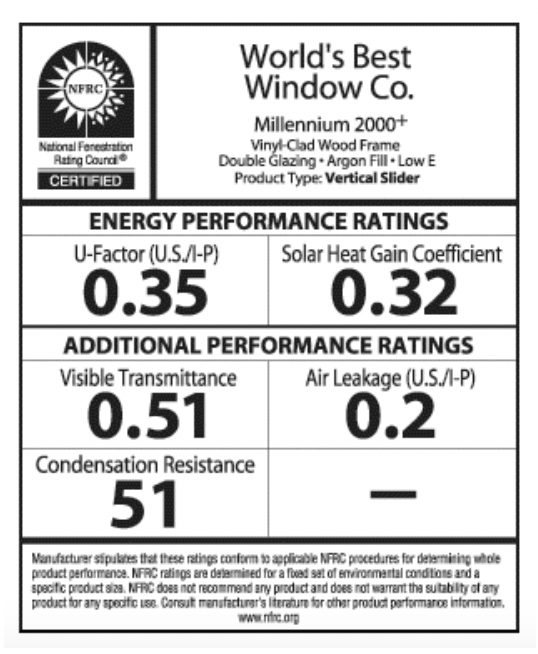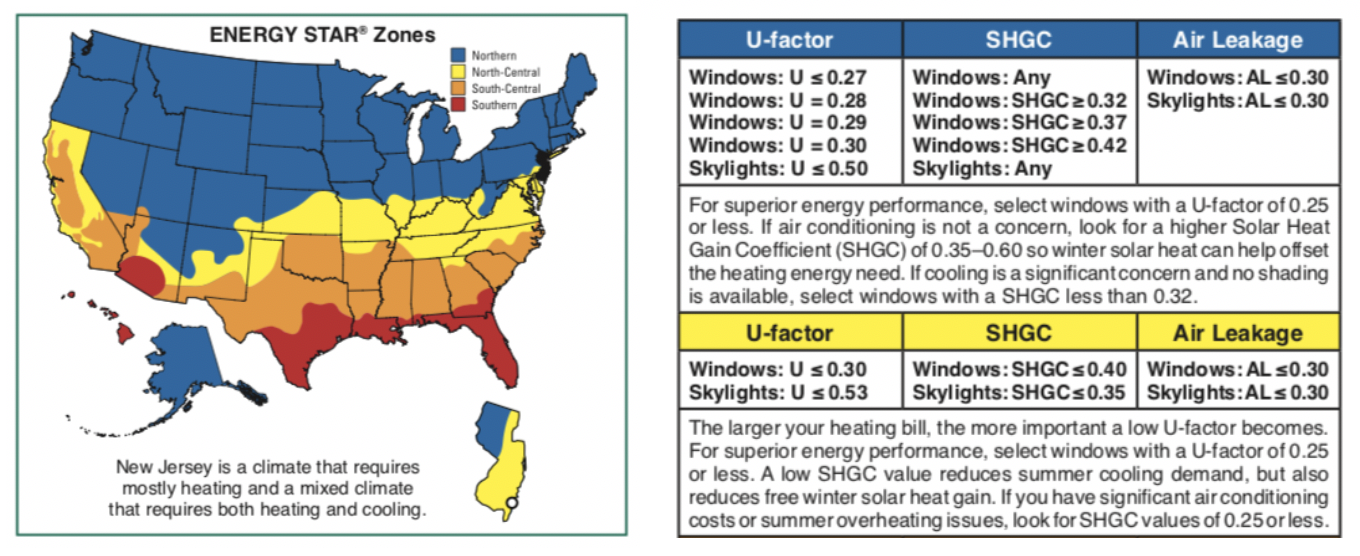Energy-Efficient Windows
New ResidentialWhat are Energy-Efficient Windows?
Windows form part of the fenestration system of a building and play a key role in maintaining a highly insulated building envelope (see Insulation). The fenestration system, or arrangement of openings in a building envelope, determines a building’s HVAC requirements and daylighting.[1] Energy-efficient or high-performance windows maximize natural light and minimize glare and heat gain or loss, decreasing dependence on electric lighting and HVAC systems and improving thermal comfort, energy-efficiency, and daylighting (see Daylighting and Glare and Heat Gain Reduction).[2]
High-performance window technologies including low emissive or low-e glass panes, spacers, and insulated frames help prevent energy loss due to conduction, radiation, convection, and air leakage (see Air Infiltration).
Low-e windows, treated with a microscopically thin coating, reduce heat flow. Spacers or tiny pieces placed between panes in double- or triple- paned windows, create an insulated space often filled with an inert gas such as argon or krypton to decrease heat loss through the window.
State and local energy codes, federal tax credits, and utility incentives, and ENERGY STAR base their criteria for energy-efficient windows on certified ratings by the National Fenestration Rating Council (NFRC). NFRC labels provide ratings for U-factor, Solar Heat Gain Coefficient (SHGC), Visible Light Transmittance (VT), and optionally Air Leakage (AL) and Condensation Resistance (CR) ratings (See Figure 1).

Figure 1 – Example of NRFC certified window unit label. (Source: The Efficient Windows Collaborative)
A window’s U-factor describes its rate of heat transfer or insulating properties. A lower U-factor indicates a window with higher resistance to heat flow, or a better-insulated window.[3] The Solar Heat Gain Coefficient (SHGC) indicates how much of the sun’s solar heat energy transmits through the window as heat. As the SHGC increases, the solar gain potential increases. Visible transmittance (VT) refers to the amount of visible light transmitted through the window. A higher VT means more daylight in a space. Advances in high-performance tinted glass and low-solar-gain low-e coatings reduce solar heat gain while maintaining visible transmittance. The Air Leakage (AL) rating describes leakage through cracks in the window assembly. Condensation Resistance (CR) rates windows on a range between 1 and 100 with higher numbers signaling increased resistance to condensation.
How to Incorporate Energy Efficient Windows
Use simulation programs such as the Efficient Windows Collaborative Window Selection Tool or Berkeley Lab’s RESFEN to determine energy-efficient and cost-effective window options. Look for the ENERGY STAR label, which sets standards for energy-efficiency that often exceed local energy code requirements.[4] When selecting a window based on performance, look for visible transmittance (VT) levels higher than (> 70%), especially for daylighting applications (see Daylighting).[5] For New Jersey’s Northern/Central climate zone, EnergyStar recommends SHGC of 0.4 (40%) or lower for homes with moderate air conditioning requirements. Look for SHGC values of 0.25 or less for homes with significant air conditioning costs or summer overheating problems.[6] For New Jersey’s Northern/Central climate zone, a U-factor of < 0.25 is recommended for high-performance homes (see Fig. 2).[7]
Window performance depends on proper installation, sealing and flashing to prevent air leakage and water damage. Window manufacturers often provide detailed installation requirements and specifications for their products and may have recommendations of in-house installers and programs, 3rd party installers, or installer certification programs such as Installation Masters™. ASTM Standard E 2112 provides a nationally recognized standard for proper window installation.

Figure 2 – ENERGY STAR Recommended U-factor, SHGC and Air Leakage values for New Jersey’s Mixed Climate (Source: The Efficient Windows Collaborative)
Benefits
Energy-efficient windows contribute to the satisfaction, health, and productivity of building occupants by providing daylighting, reducing glare, providing views of nature, and regulating thermal comfort. By providing natural light, managing glare, and eliminating the need for window treatments that completely block out sunlight, high-performance windows can reduce electric lighting loads while at the same time reducing the ultraviolet (UV) and other solar radiation which causes fading of fabrics and furnishings. Heat gain and heat loss through windows represent 25%–30% of residential energy use from heating and cooling.[8] Installing low-e windows can save 12%–33% on heating and cooling costs, depending on the climate, window orientation, window area, shading devices, and window frame and glazing type.[9] Energy-efficient windows designed as part of an overall energy management strategy can lead to mechanical equipment downsizing, saving capital costs, and reducing mechanical loads and operating expenses (see Properly-Sized HVAC System).
Costs
The average national cost of window installation is $5,040, with most homeowners spending between $2,584 and $7,497.[10] ENERGY STAR estimates that upgrading from a conventional single pane window to an ENERGY STAR certified window in the Mid-Atlantic region saves an average of $236 (20%) in one year.[11] Energy savings help offset the higher upfront cost of energy-efficient windows compared to conventional windows.
For up-to-date information on available incentives, visit the ENERGY STAR and the NJ Clean Energy Program websites.
Resiliency
In the event of a power outage, a home built with energy-efficient windows maintains comfortable internal temperature for occupants by reducing heat gain and reducing cooling loads during the summer months. During the winter months, energy-efficient windows provide better insulating properties compared to conventional windows while also offering daylighting, passive solar heating, and enhanced thermal comfort in the case of a power outage. Energy-efficient windows reduce reliance and stress on the grid and provide energy savings. In areas prone to flooding, wind-driven rain, snow storms or hurricanes, properly sealed and flashed windows protect against problems caused by water intrusion, including mold, warping, and structural damage.
[1] Whole Building Design Guide (WBDG) – Windows and Glazing http://www.wbdg.org/resources/windows.php (accessed April 10, 2018).
[2] Efficient Windows Collaborative. Understanding Windows. http://www.efficientwindows.org/understanding.php (accessed April 10, 2018).
[3] The Efficient Windows Collaborative. U-Factor. http://www.efficientwindows.org/ufactor.php (accessed May 4, 2018).
[4] Energy Star. http://www.energystar.gov/index.cfm?fuseaction=find_a_product.showProductGroup&pgw_code=WI (accessed April 8, 2018).
[5] Whole Building Design Guide (WBDG). Windows and Glazing. https://www.wbdg.org/resources/windows-and-glazing (accessed April 8, 2018).
[6] Ibid.
[7] The Efficient Windows Collaborative. “Selecting Energy Efficient New Windows in New Jersey.” January 2016. http://www.efficientwindows.org/factsheets/New%20Jersey.pdf (accessed May 9, 2018).
[8] US DOE. Energy Savers. Windows https://www.energy.gov/energysaver/design/windows-doors-and-skylights/update-or-replace-windows (accessed April 10, 2018).
[9] Ibid.
[10] HomeAdvisor – True Cost Guide – Installing Windows https://www.homeadvisor.com/cost/doors-and-windows/install-windows/ (accessed April 6, 2018).
[11] ENERGY STAR. Benefits of ENERGY STAR Qualified Windows, Doors, and Skylights. https://www.energystar.gov/products/building_products/residential_windows_doors_and_skylights/benefits (accessed April 10, 2018).
Resources
- American Architectural Manufacturers Association (AAMA) – Caring for Your Windows, Doors, and Skylights
- Efficient Windows Collaborative
- Energy Star – Windows, Doors, and Skylights
- Installation Masters – Window & Door Installer Program
- National Fenestration Rating Council (NFRC)
- Rensselaer Polytechnic Institute – Lighting Research Center
- US DOE – Energy Savers
- Whole Building Design Guide (WBDG)
